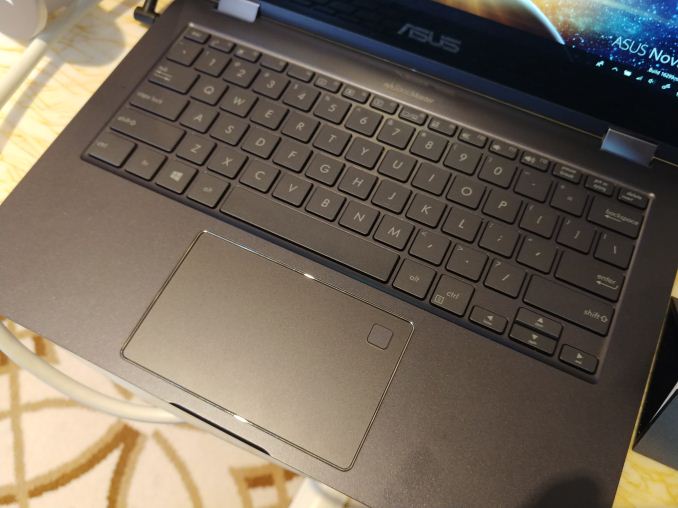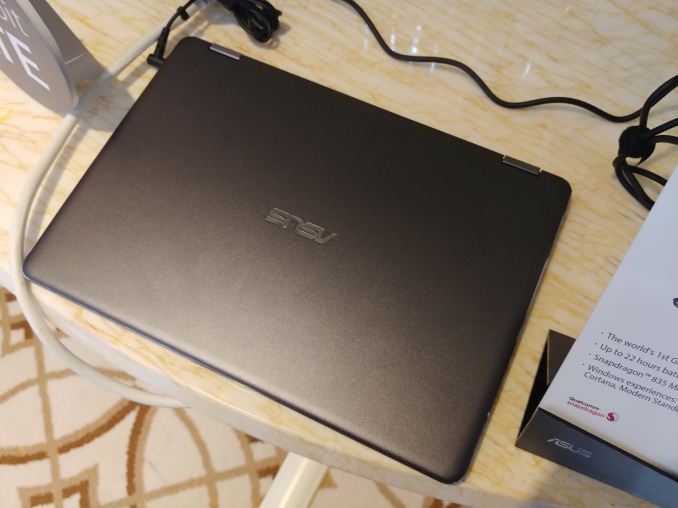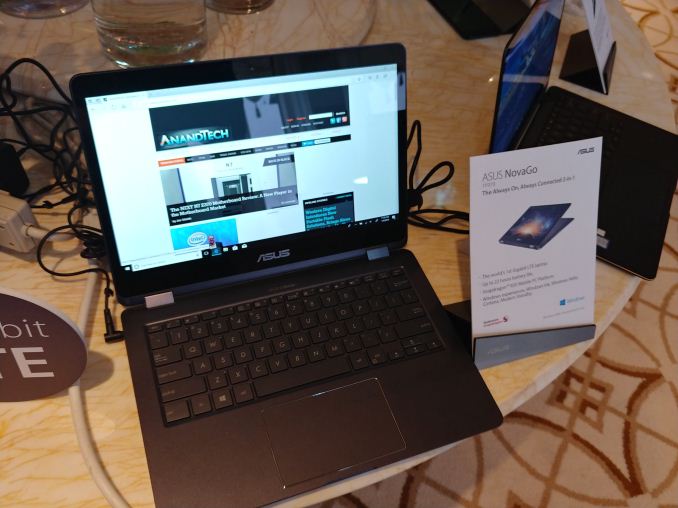The ASUS NovaGo: Two Minutes with Snapdragon 835 and Windows
by Ian Cutress on January 17, 2018 8:00 AM EST
LAS VEGAS, NV – Late last year, at Qualcomm’s Snapdragon Tech Event in Hawaii, we had the formal introduction of the first devices that were using the new Windows on Snapdragon platform and Qualcomm’s dream of bringing mobile technology to laptops to provide ‘Always Connected PCs’, connected through an LTE data connection. Qualcomm sells the upsides of this technology of providing laptops with 20hrs+ of battery life through using a smartphone processor, and through working with Microsoft, have a full version of proper Windows based on the system. The devices use native apps for best performance through the Windows Store, however 32-bit apps are machine translated into instructions that the Snapdragon SoC can process. It’s a lot of technology in a tiny device, and Qualcomm would seem to be the first CPU manufacturer to actually pull off x86 translation for the consumer market.
All of that aside, one of the first devices that should enter the market is the ASUS NovaGo. This is a 13-inch premium laptop/360-degree 2-in-1 design that has features such as Windows Hello and a fingerprint sensor built in while maintaining ASUS’ laptop quality and claiming up to 22 hours of battery life. We have wanted to get our hands on one for a while, and I managed to get a couple of minutes at the show with one at the ASUS suite.
Truth be told, the main fear that we have had with these devices is responsiveness. Smartphones on Android can be fast, with but something much bigger like Windows, it was not always on the cards that we would get the same level of responsiveness as, say, a Y-series Intel design. Back when we saw a super-early demo behind closed doors at IFA, it wasn’t the fastest, but on the NovaGo at least, everything seemed in order. Basic applications were quick and easy to open, and no visible lag from my untrained eye. Using the native compiled version of Edge, the best website in the world loaded as it normally does, and I was able to navigate the device as I would do normally with an Intel based laptop. Being familiar with ASUS’ device design, there were no surprises in the feel of the keyboard and touchpad either. Port support extends to a 3.5mm jack, a HDMI port, and two USB 3.0 ports.
A quick look through the system settings showed eight Snapdragon 835 cores, the Adreno graphics, and a PCIe based SSD for storage if I remember correctly. With it being connected to the internet, I tried downloading CPU-Z, even in 32-bit, but it required me adding it through the Store page to get it to work. Alas, the Wi-Fi at the Las Vegas Encore was not giving me any favors with the Windows Store so I was unable to go down that route, so at some point I obviously want to see the effects of x86 translation.
We were told by Qualcomm at the event a number of interesting things about the design of the platform, and how it has changed since we last met with them. Windows scheduler is configured to deal with cores of different level of performance, and it knows what programs are where and how to deal with them for performance and power, much like a good Android based scheduler. This was one of our worries, but we were categorically told that any internal worries they ever had are now fixed and it should run like a well-oiled machine.
In gaming, Qualcomm stated that with the modern APIs, the Adreno GPU is natively compiled and doesn’t need translation. As a result, due to the way that Adreno works, for some titles it ends up being more computationally efficient over other solutions and causes less work on the CPU, allowing for more of the power budget on the GPU and an overall better frame rate. Obviously we want to get a hold of the device and test the claim, but if offers an interesting prospect.
As for the NovaGo, with the addition of LTE and if it stands up to the battery life claims, it could be a neat little device depending on the price. ASUS said they expect it to launch sometime during Q2.















76 Comments
View All Comments
serendip - Wednesday, January 17, 2018 - link
My mistake then. UFS should be a significant speedup over the pokey EMMC used on Atom tablets. I should know, I've used Bay Trail and Cherry Trail tablets and I find the slow storage to be the biggest performance issue.A 10" Snapdragon tablet running full Windows with x86 translation could very well be my next ultralight machine, if the price could go below $500. I'd buy it in a heartbeat at $300. Cherry Trail is still being used in this space because Intel and AMD have nothing comparable re. TDP and SDP. Snapdragons have much lower idle power and more efficient GPU blocks so a Windows tablet with 12 hour battery life should be doable.
lazybum131 - Thursday, January 18, 2018 - link
Agreed, for me a 8" tablet to replace my aging Dell Venue 8 Pro (Bay Trail) would instantly get my money at $500 if done right, maybe even higher as it would also replace my nearly 11-year old Latitude D630 laptop that's permanently docked.ikjadoon - Wednesday, January 17, 2018 - link
Read the article. It's PCIe. Slow down. Read more carefully. You'll find the quote....I hope.Cherry Trail? Oh, gosh. Please never recommend a laptop to your close friends. They'll hate you sooner or later. And a tablet? What tablet has a proper keyboard like that? With backlighting?
Come on. Give evidence. Backup your claims. We're not politicians.
CyberAngel777 - Sunday, April 8, 2018 - link
Not PCIe, but UFS 2.0ZolaIII - Thursday, January 18, 2018 - link
When Chinese get to it massive you will be able to get ARM QC & other ones based for a same price as current Atom based ones as guess what SoC price difference is small.ikjadoon - Wednesday, January 17, 2018 - link
Silly jjj. Keep your fantasies to yourself; they're ferment better there. ;)If you feel so confident, please share your $600 MSRP laptop recommendations. Let's pick them apart! :D
Not low-perf enough for people to care. Memory, sure. Storage: who do you think buys $600 laptops? Yeah, $10 that doesn't get spent. You better go call Acer: you're blowing their mind right now. A FP sensor is only $2? Damn, what a missed opportunity!
LTE: pennies for Qualcomm, kiddo. Do you understand what article you're commenting on?
Very few need it: yeah, tell that to Android OEMs and Apple. Nobody needs LTE! /s
Afford LTE: yeah, I'm ready for the 20-hour laptops with LTE. Please, educate us all. ;D
It won't compete with Atom and you know it. It's all right to admit it here in the comments; nobody knows who you are. :D
"Insist on LTE": how dare they allow more mobility. A crime!
People stupid enough to buy it = "People use computers different than me. And that's not fair. Let me belittle their intelligence because I use computers in the right way."
Man, did school get cancelled? How do such inane people get on Anandtech's comments? You'd think the quality of Anandtech would rub off on its commenters, but you're a shining example of that failure. Welp. At least we can see the rest of your...comment history.
ZolaIII - Thursday, January 18, 2018 - link
He is CEO at EETimes. & who are you?I hate him for it's stubbornness but never the less we base our debates on back bone and grounds based on facts.
ZolaIII - Thursday, January 18, 2018 - link
Yes but from greedy ASUS & look alikes.The S835 SoC costs about the same as newer Atom one, while performance & power consumption of S835 is still considerably better. The rest components depending on used one's respectively cost the same. S845 won't be much more pricier & it's development ready. Qualcomm could turn the page upside down making the real SoC for portables & ultralight as they have their wider OoO for now server only CPU core's & Adrenos are scalable enough. But we both know that this ain't happened at least not anytime soon. Now just imagine SoC containing 6 next gen OoO QC now server based core's coupled with two more A55's on DinamIQ cluster backed up with Adreno graphics with 512 ALU's (twice as much as current flagship one's) on the newer 7nm FinFET. DTP would stay in ultra portables range 5~6W with much better efficiency in idle and low light usage conditions (thanks to A55's), more general purpose CPU power thanks to 6 bigger OoO core's & significant enough GPU. Not only it would put at risk Intel Y series but it would also Hit AMD and Nv regarding GPU power at that DTP. I am confident that neither of them would have answer to that. Still SoC like that would probably be chipper for one third from Intel Y series based on up to date Intel pricing.
serendip - Thursday, January 18, 2018 - link
You must be ZolaIII from XDA. A fellow Mi Max owner :)Apollo Lake doesn't go below 6W TDP whereas Cherry Trail could hit 2W. Maybe Intel killed Willow Trail because it couldn't get competitive 3G and LTE onboard. I'm fine with the SD835 if these machines are to be released right now. A Q2 or Q3 release should use the SD845 instead. Hopefully cheap and cheery Chinese OEMs will start cranking out $300 Windows ARM tablets soon.
CyberAngel777 - Sunday, April 8, 2018 - link
I have Mi Max 2 so my opinions are twice as good and... I agree...twice! ;-)I'm waiting for Build 2018 & SD 845 models - June earliest(?)